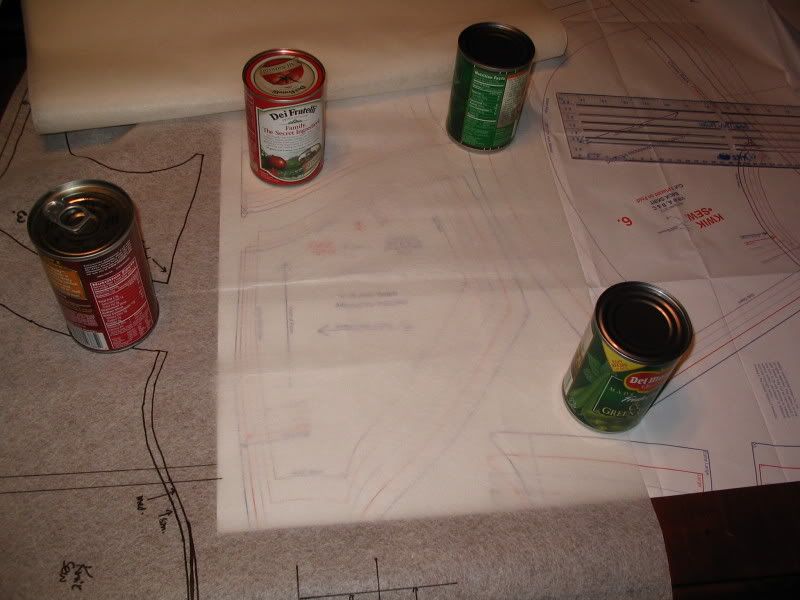 Those of you who sew often know this little alterations trick, but as I set out my soup cans, I thought that some of you who are new to sewing might not know about it.
Those of you who sew often know this little alterations trick, but as I set out my soup cans, I thought that some of you who are new to sewing might not know about it.What you see in the photo on the left are my soup cans, a multi-sized pattern (but a regular pattern will do), a see-through ruler, and sew-in stabilizer.
The stabilizer is the key to this trick. Buy the cheap stuff ($1/yd), nice and thin, and make sure it's sew-in. (When you wrinkle the pattern pieces, you can iron the sew-in variety. The one with little glue dots will stick to your ironing board.)
Hold the stabilizer and pattern down with soup cans. Trace the pattern using the see-through ruler and Sharpie markers; make your alterations right on the pattern pieces. You can see on the left where I've extended the bodice as well as increased the width of the seam for the bodice. The panties, I know from sewing this brand of pattern before, fit fine, so I'm altering them just where they hit the bodice.
I used to think that altering patterns was a waste of time - I'd just cut that bugger up and save myself a bit of time. What's 10 bucks for a new pattern? Yeah. Only some patterns are close to $20 and gas is close to $4. Ice is $10 an hour and I've come to my senses. I've already cleared the table to cut; I might as well spend the extra 30 minutes to trace the darn pattern and alter it.
Then, when Ice Girl grows, the pattern will live on and I can make it again without wasting money, gas, trees, etc. Oooh. I feel so green. :)
Side note to new figure skating dress sewers: I used to be frustrated that the patterns didn't feature measurements or symbols at key areas like bust, waist, and hip. That was me in normal sewing mode. There shouldn't be any ease on a figure skating dress pattern because it's supposed to fit like a second skin. When I realized this, I bopped myself on the forehead. It seems obvious, but it wasn't to me. Just measure your skater's actual hip, waist and bust, and measure where those places hit your skater. Find the waist on the pattern (where the pattern cinches in) and locate the bust and hip on the pieces. You can then measure the pattern with accuracy. Best wishes for success! Ice Mom











3 comments:
I use soup cans too! Years ago I was given pattern weights for Christmas, but that was when I only quilted, I had no idea what you would do with them and got rid of them. Now that I know, they are gone and I use tuna or soup cans.
Sew in stabilizer is a great idea to avoid wrinkles. I use tissue paper (like the kind you use for gift wrap) but I have to retrace everytime I remake the pattern, because it tears easily.
My problems with alterations is I still never know exactly what to alter and by how much. I've figured out how to lengthen skirts, but not how to add to the hips/waist and take out the torso effectively, so I still end up doing a lot of post-sewing alterations. So far 2 out of 3 tries have resulted in wearable dresses, but neither is perfect...
One of my favorite books about altering patterns is Nancy Zieman's Fitting Finesse. It shows a pivot and slide technique that you can use to alter patterns almost flawlessly.
I was wondering if you knew why the seams start to wrinkle and ot lay straight. Or do you suggest anything to fix that problem.
Thanks,
Van
Post a Comment